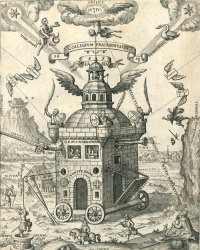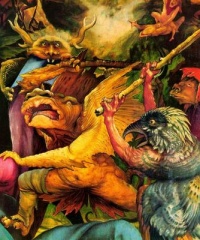Vision (spirituality)
From The Art and Popular Culture Encyclopedia

Illustration: The Ecstatic Virgin Anna Katharina Emmerich by (1885) by Gabriel Cornelius von Max

Illustration to the Speculum Sophicum Rhodostauroticum (1618) by Teophilus Schweighardt Constantiens

|
Related e |
|
Featured: |
In spirituality including religion, visions comprise inspirational renderings, generally of a future state and/or of a mythical being, and are believed (by followers of certain religions) to come from a deity, sometimes directly or indirectly via prophets, and serve to inspire or prod believers as part of a revelation or an epiphany. Many mystics take the word vision to be synonymous with apparition.
For religious visions as a literary form, see apocalyptic literature.
Religious visions are generally categorized as miracles. Like speaking in tongues and unlike raising the dead, visions can be readily forged.
In the Eastern Orthodox Church, in addition to the religious visions mentioned above, the term vision (theoria) can refer to the experience of the "Energies" of God, as the result of the purified nous.
Artistic inspiration may provide a special category of the ecstatic vision: traditionally in such cases the semi-divine Muses may transmit the visioning to their loyal followers.
Visions generally have more clarity than dreams, but traditionally fewer psychological connotations. The psychological mechanism to engender visionary perception and trance phenomena is focussed intention and attention.
Entheogens (such as peyote) have traditionally assisted in the generation of visions among diverse cultures, as well as in modern western culture.
Some could consider visions to be a manifestation of the 'aha' (lightbulb going off) type of learning associated with Picture thinking or Visual Spatial thinking.
Examples of visions
- Vision of God in the Book of Ezekiel
- vision of a heavenly figure "like a son of man" in Daniel
- Jesus' vision of the dove when baptized in the Book of Mark
- Paul's vision of Christ (a part of Acts of the Apostles)
- the apocalypse in Revelation
- the theoria (vision of God) by which Jesus' disciples discerned the trinity (in the Eastern Orthodox tradition)
- visions of the afterlife in the martyr accounts of Perpetua and Felicity
- Constantine's vision of Christ's sign
- Emanuel Swedenborg's visions, which formed the basis of a newly revealed doctrine
- Jakob Böhme's vision, revealed when he observed the beauty of a beam of sunlight in a pewter dish
- Joseph Smith's First Vision
- Lehi's vision of the tree of life
- Angels of Mons
- Marian apparitions
- Nat Turner
See also
- Private revelation
- Altered state of consciousness
- Apparitional experience
- Beatific vision
- Mysticism
- Hallucination
- Kashf
- Neurotheology
- Shamanism
- Temporal lobe epilepsy
- Theophany
- Vision quest

